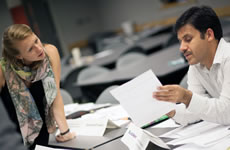A simulated earthquake trains students to coordinate disaster response
 The July 25 Health Emergencies in Large Populations class (HELP) was a disaster.
The July 25 Health Emergencies in Large Populations class (HELP) was a disaster.
Not a commentary on the quality of teaching or student performance, the annual disaster simulation exercise is the culmination of the popular Summer Institute course.
This year’s students confronted a major earthquake in the Neper province of Dearland. In the roles of public health and safety officials in the developing country, students assessed damage, coordinated assistance and communicated essential messages to the public.
“It’s a way to bring together everything they’ve learned and see how some things that in class seem orderly in class are not,” says International Health professor Gilbert Burnham, MD, PhD, MS, longtime director of HELP. “Every disaster is different, but they all have chaos and confusion.”
Claude deVille, retired director of disaster response with the Pan American Health Organization, has worked with Burnham for the past 12 years to develop the annual crisis scenarios.
“You are prisoners of the speed of the disaster, you have to make decisions,” he told students as they take on their roles at the Emergency Operations Center.
The buzz in the classroom builds as the disaster rapidly unfolds.
“Have we made contact with the affected area?”
“I don’t need human resources; I need first aid kits, antibiotics, vaccines.”
“We’re moving the displaced to three refugee camps.”
For student Andrew Etsano, a real-life Canadian Red Cross staffer, found the exercise extremely valuable. “It’s important to see how teams work together in the field under intense pressure,” he says.